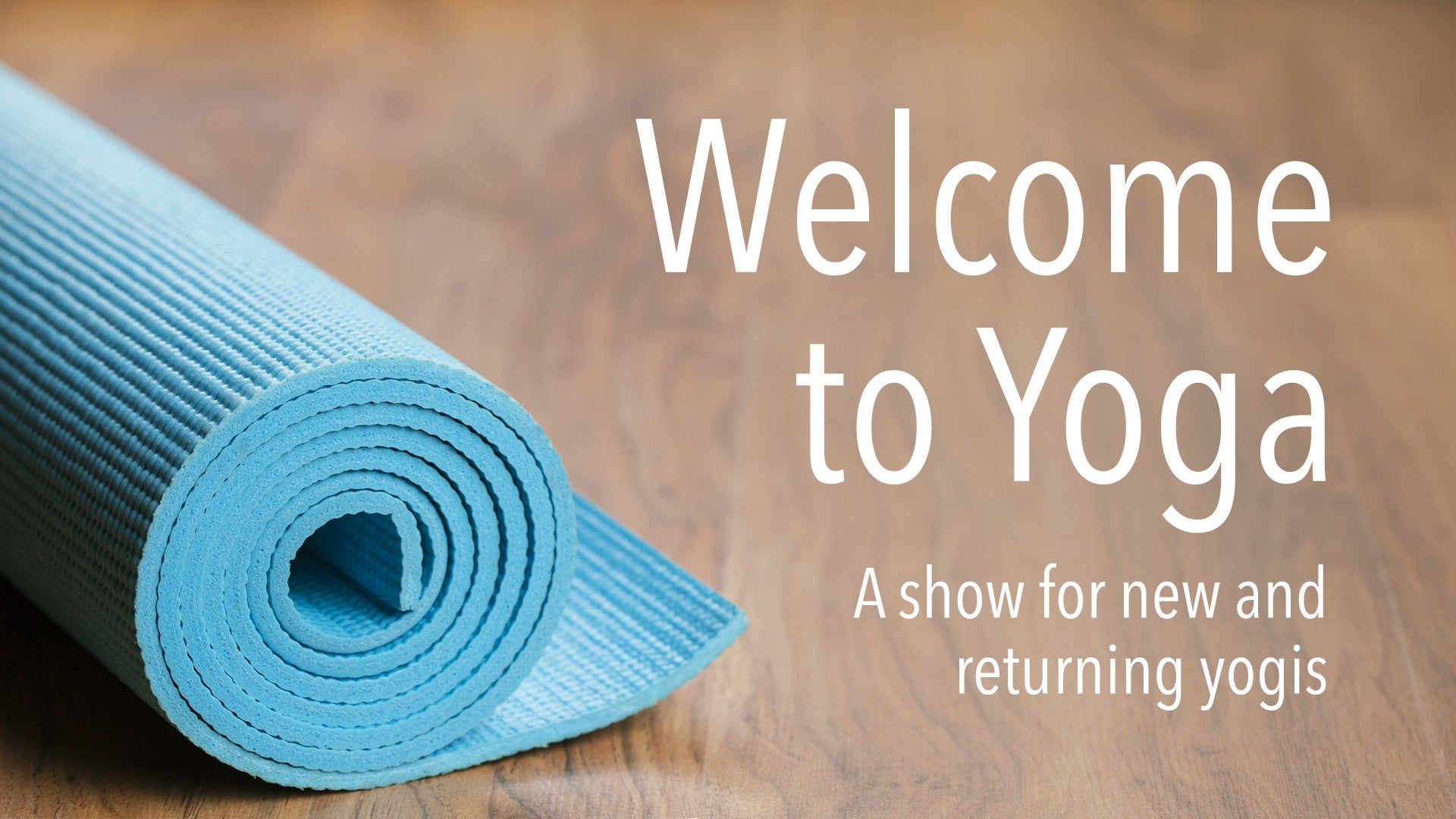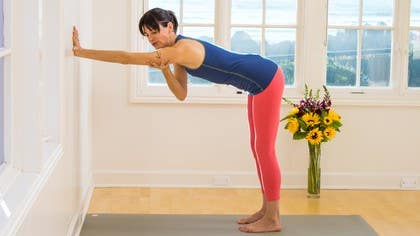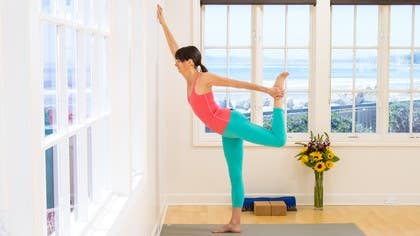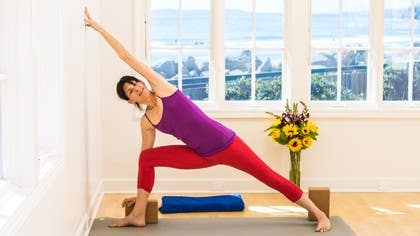Description
About This Video
Transcript
Read Full Transcript
(waves crashing) Hi and welcome. I wanted to spend a little bit of time talking about a very popular yoga pose these days, downward-facing dog. In Sanskrit the pronunciation is adho mukha svanasana. Sometimes you'll have a yoga teacher just rattle that off and you'll know what it is now. So just say it with me.
Adho mukha svanasana. I had a teacher once that told me that when I speak in Sanskrit, it opens the channels of my body so I want to share that opening with you. So we're gonna start by talking about the arms. Take your arms out to the side and roll them so the palms face up. This is called external rotation.
And then roll your palms so they face down. Internal rotation. Go back and forth a couple of times. External rotation and internal rotation. And as you do this, notice how the shoulders feel and the upper chest.
Maybe the tops of the lungs. And you may notice that when you externally rotate your arms, there's more opening and freedom across the chest, which is something that we need in this world. Open chest versus a collapsed chest. Open heart. So external rotation can get a little confusing when we put our head down and reach our arms up over.
So I'm gonna just geek out and draw an arrow on my arms to indicate the direction of external rotation and you can imagine that you are also drawing an arrow on your arm. I don't have any tattoos, but if I had one this is the one that I'd want. Okay so that's external rotation. Externally rotate your arms. Keep them externally rotated and then turn your forearm so the palm faces down.
Notice how you have this incredible human ability to keep your upper arm stable but turn your forearm. So as our arms externally rotate in downward dog, our forearms actually have to turn in and then we have to give a little extra attention to the rooting of the index finger knuckle and the thumb knuckle to balance the external rotation of the upper arm. Got it? Okay. So gonna put my pen down and we're gonna try downward facing dog first at the wall, which is a little bit easier in that it doesn't bear weight into the shoulders. Start with your hands right about waist height and then step your feet back so that your spine is parallel to the ground.
If this is very demanding on your hamstrings, bend your knees a little bit. And then if you could just peek up at me for a moment. If you are naturally flexible, you might be sinking this way. If you're tighter, you may be lifted up this way. If you're flexible find some stability underneath your arms, underneath the front of the spine so you feel supported from the bottom.
If you're tighter, take your hands a little bit wider and turn your fingers out to the sides. Okay and then here we go. We're gonna take the right hand to the left arm and externally rotate that arm. Follow the direction of the arrow. And then hand to the wall, other side.
Externally rotate that arm. Feel how it widens the shoulder blade. Widens the chest as well. And then bring your hands back to the wall. Peek at your feet.
I have a whole tutorial on feet, which you should watch. The toes lengthen, the balls of the feet ground, the center of the heels ground, and the arch of the feet lift up to create energy all the way up through the legs. Don't let your head drop down and create weight on your shoulders. Keep the head as an extension of the center of the chest and breath here. Breath and feel.
Walk forward. One of my favorite things that the Budhha said was, "Don't believe anything that I say. "Try everything out for yourself, see what works." Please come down to your hands and your knees and walk back so that your heels are close to the wall. In downward dog you want a little bit of a longer stance than just regular hands and knees where your shoulders are over your wrists. So walk your hands about four inches forward and let's talk about the hands.
Index finger knuckles for today for these purposes, to help the external rotation of the upper arm, straight forward. Look at your index fingers, make them parallel to each other. They're pointing straight forward. And then instead of just spreading your fingers, feel as if you can spread the whole palm of your hand into the ground. Take your elbows straight out to the side like a bulldog and then swing your elbows back, finding that feeling of external rotation.
Keep the outer arms rolling back as you straighten your arms. That little exercise works pretty well to get the arms into the correct rotation. It's healthiest for the shoulders. Elbows out to the side, they swing back. You can feel how that integrates and organizes your shoulder blades.
And then the arms straighten. If you have very loose elbows and you can really roll your arms around, if they're...you have the carrying angle or you're double jointed or hyper extended and the arm over straightens, don't overdo this action. Those kind of elbows have this inner elbow facing the other inner elbow. You can let go of that rotation cause it's so easy to overdo if you're, I'm gonna say like six percent of people have those really flexible elbows. Okay, from here we have to externally rotate those arms.
Therefore, ground the two points that I drew on my hand. Index finger and thumb knuckle ground. Balance that opening of the upper arms and then lift your pelvis up and back. Let your heels rest onto the wall. That just gives you another little anchoring point.
And reach your arms forward. If your back is rounded, that puts a tremendous amount of weight onto your wrists and your shoulders and your back rounds because your hamstrings aren't letting your pelvis lift up. If that's the case, bend your knees, press into your hands, lift your pelvis up and back. On the flip side of that is the flexible people that again like I showed at the wall fall into the front body. If that's you find support in the front of the body.
So you feel the spine elongated, free, spacious. Not in a forward bend or in a backward bend. Externally rotate the arms. It's challenging. Just keep going back to it.
Lengthen the whole spine, draw the tops of the thighs back like the legs are being sucked into the wall behind you. And then bring your knees to the floor, sit up. We'll relax the wrists for a moment by interlacing the fingers and just letting your wrists go around and around. A little wrist dance. Again in the opposite direction.
And let's just do one more downward-facing dog, this time with the heels off the wall and there's a common misconception that the heels have to touch the ground in downward-facing dog. For many people the heels, including myself, the heels have not touched the ground yet and I've been practicing yoga for I don't know how many years. Many years. But the heels are moving in that direction. The calfs, the Achilles tendons are lengthening so that the heels are moving towards the ground but they may not touch.
So, again, we'll come to our long hands and knees. Index fingers root, thumbs root to balance that external rotation of the upper arm. Feel the chest broad. Again, if your shoulders are tight, taking the hands wider, turning your hands out more will make it a little more accessible for you. The knees come up off the ground, pelvis lifts up and back.
Legs straighten if you have the hamstring ability to do that. And then just notice. A couple more points here. Notice the very center of your palm. There's a little lift in the center of your palm.
You probably notice it's not flat into the ground. We want that little lift. And imagine that little lift in the center of the palm is sucking energy right out of the Earth and then your arms are like two drinking straws just (makes slurping sound) sucking the energy up through the arms, through the shoulders, through each rib, through your waist and the pelvis pulls back. It's an immensely energetic pose. The thighs pull back and then the heels release towards the ground any amount.
You're breathing. Softening what can be softened. Release knees to the floor. Just take a moment in child's pose and let's do this child's pose if it's comfortable with the arms back. Backs of the hands by the feet and the shoulders completely passive.
The upper arms, elbows, forearms, wrists, fingers, soft. If letting the pelvis release down like this is challenging for you, you can have your pelvis up and your head unto your hands. And then roll up and this would be a great practice to take into any other practices here on Yoga Anytime. Thanks for watching.
Welcome to Yoga: Explore the Fundamentals
Comments
You need to be a subscriber to post a comment.
Please Log In or Create an Account to start your free trial.

















